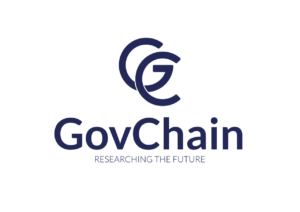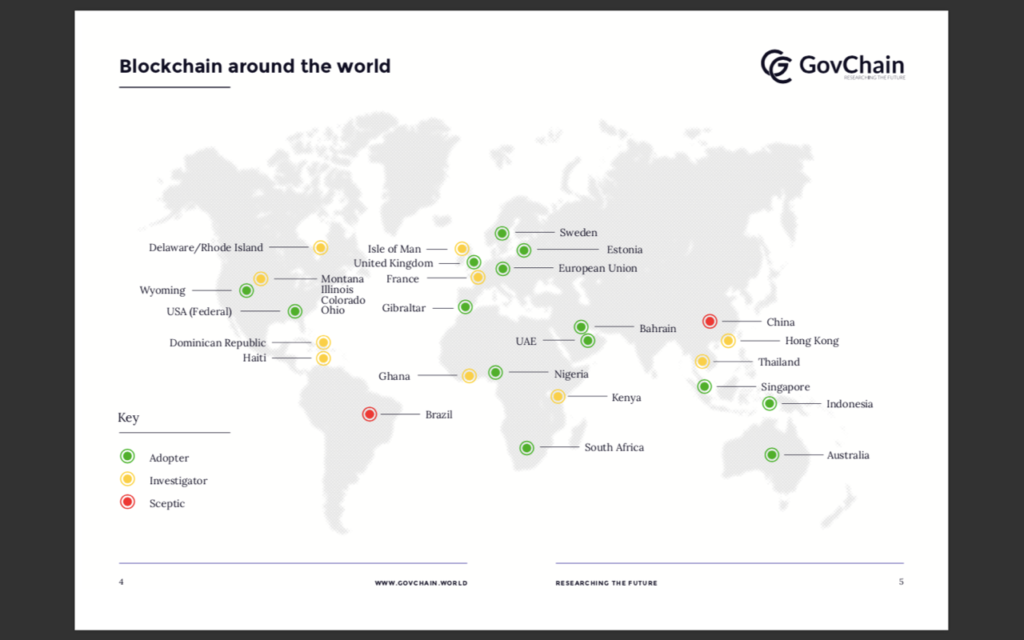By Helen Disney – CEO and Founder of Unblocked, cofounder of GovChain and founding board member of the British Blockchain and Frontier Technologies Association (BBFTA)
15 November 2019

What is the current state of implementation of blockchain by public sector bodies around the world?
Over the past year a project known as GovChain has attempted to answer this question. Our research team – composed of researchers with a mix of expertise in both blockchain and public policy – mapped the regulatory and policy environments of countries around the world to assess their degree of friendliness towards blockchain and Distributed Ledger Technology (DLT). We also spoke directly to leaders within public sector organisations, who had attempted to implement blockchain directly. We asked what were the key drivers that allowed them to make a change – was it funding, political leadership, policy environment, cultural factors or something else? And what could other countries learn from successful approaches to help them accelerate change?
The resulting body of work is, we believe, the first project of its kind to gather such detailed information about the progress of blockchain in the public sector around the world. Countries were ranked as Green (Adopters), Amber (Investigators) or Red (Sceptics) according to the “blockchain-friendliness” of their regulatory environment, as well as their level of blockchain adoption within the public sector. Twelve countries were ranked as Green as well as the EU area as a whole and the US state of Wyoming, which has been progressive in its approach to regulation. Seven countries were ranked as Amber, as well as 5 US states which have enacted blockchain-specific initiatives or regulations. Brazil and China were ranked as sceptics largely due to the high degree of political uncertainty surrounding implementation, although since the report was launched, China’s President Xi Jinping recently delivered a glowing endorsement of distributed ledger technology and the country has launched range of new initiatives including moves to create its own national cryptocurrency.
GovChain – Blockhain around the world

While our traffic light categories are necessarily subjective and rankings will change over time, the aim was to provide an ‘at a glance’ reference point for how countries are doing – as well as to stimulate debate and knowledge sharing on what can be improved and how we can learn from one another’s efforts and approaches. After scanning the results of both the regulatory mapping process and the in-person interviews we conducted with policymakers, we produced a set of policy recommendations drawn from the common themes which emerged from our research. These are summarised below:
1. Carry out a cost/benefit analysis of upgrading public sector IT Systems using blockchain/DLT
Trend: Blockchain can be understood as a more efficient way of recording and transferring data. Any application that involves exchanging data could thus theoretically make use of the technology. It therefore has the potential to be as ubiquitous as the internet, underpinning virtually all transactions. Therein lies a major challenge for Governments across the world. Blockchain functions best when all parties in the transaction take part, whether this is everyone on a supply chain, a benefit scheme, food traceability, and more. Even for the sophisticated and technologically advanced jurisdictions, this is a daunting task. The public sector is infamous for being slow at updating legacy systems. Whereas private businesses embrace innovation, governments are understandably more risk averse, constrained by major responsibilities. Perhaps unsurprisingly, it was observed that smaller jurisdictions found it easier to upgrade their existing infrastructure than their larger peers. Thus, while Estonia, Bahrain and Gibraltar have shown great flexibility in accommodating blockchain applications, whether that is via regulatory changes or use cases, larger countries such as China and the U.S. are taking longer to shift. Interestingly, it is often at the state or provincial level that developments first occur, such as in the Chinese Districts of Chongqing Yuzhong and Hangzhou or in the U.S. state of Wyoming.
Recommendation: Governments should look to the successes at the local level, learn from the experiences gained and carry out a cost/benefit analysis of upgrading public sector digital systems nationwide using Blockchain/DLT.
2. Promote international and cross-border cooperation
Trend: Due to being decentralised and distributed, blockchain is cross-border by nature. The most popular applications, such as Bitcoin and Ethereum, enjoy users from across the globe, who are subject to drastically different regulatory frameworks. These differences hamper growth and result in uncertainty for developers and users alike. It also leads to regulatory arbitrage, making it difficult for authorities to clamp down on illicit activity such as money laundering and terrorist financing via cryptocurrencies.
Recommendation: Some of the jurisdictions observed, such as the EU, UK, and Australia, suggest agreeing to a set of international rules and standards, further enhancing cross-border cooperation. This would allow blockchain projects to scale. Public policy should also focus on closer cooperation between national authorities, namely competition authorities, financial regulators and data protection authorities, in order to mitigate criminal activity.
3. Establish Sandboxes and Innovation Hubs
Trend: Blockchain still suffers from an image problem, as the media continues to report numerous cases of fraud, financial loss, and money laundering (ML) and terrorist financing (TF) in the use of cryptocurrencies. As a result, many Governments have in the past taken a prohibitive approach to the technology. However, as their understanding of blockchain’s potential becomes clearer, some jurisdictions are looking at ways to promote domestic innovations. From Indonesia’s Batam Island, to Bahrain’s FinTech Bay and the EU’s Blockchain Observatory & Forum, regulatory sandboxes and innovation hubs are at the heart of this strategy.
Recommendation: In order to mitigate regulatory uncertainty and promote innovation, Governments should continue to promote sandboxes and innovation hubs, supported by adequate levels of investments and continuous dialogue through public-private partnerships. Further, jurisdictions should look to participate in global forums, such as the FCA-led Global Financial Innovation Network, where they can share best practice and collaborate on common challenges or policy questions. This would not only enable regulators to share experiences of innovation in respective markets, but also provide firms with an environment in which to trial cross-border solutions, accelerating global blockchain/DLT adoption.
4. Avoid premature termination of use cases
Trend: A number of jurisdictions, including the UK, lament the habit of testing use cases, only to let the project die upon completion. There seems to be a lack of understanding from certain Ministerial Departments in the technology’s potential as numerous successful proofs of concepts are never taken to the next stage. Certain use cases, such as benefit payments in the UK and Indonesia, the trading of agricultural goods in Haiti, and the drug supply chain in the U.S., show evidence of blockchain saving public money and driving efficiencies.
Recommendation: As expressed by representatives from Bahrain and Estonia, key to successful blockchain adoption is remaining technology agnostic i.e. assessing the clear benefit in applying blockchain to a particular area of the public sector. There must be an economic rationale for moving from the traditional database infrastructure to a blockchain-based model. Once the merit of using blockchain is established, Governments should ensure that sufficient resources are assigned to test the application and, should the test be successful, establish a clear plan forward. As expressed by the UK, public sector projects must be underpinned by strong leadership. Jurisdictions with a clear plan and vision when it comes to blockchain implementation in the public sector will be complemented by an equally ambitious and thriving private ecosystem.
5. Define public procurement criteria
Trend: Whether it is IBM providing the cloud environment for the Dubai Blockchain Platform, ConsenSys writing Thematic Reports in partnership with the EU Blockchain Observatory & Forum, or the Ghana Lands Commission support for the BenBen Land Registry initiative, public procurement for blockchain projects is common among most of the observed jurisdictions. However, this method currently faces a number of challenges. Successful public procurement must be based on a legal framework that encourages free and open competition and value for money. It must also be transparent. Due to the technical complexities and cutting edge nature of the current blockchain/DLT marketplace, government departments can have difficulty in establishing trust in and verifying the quality of contractors and their extended supply chains, as well as reconciling electronic payments with assets and services. At the same time, a system actually based on blockchain could itself help to improve the public procurement process.
Recommendation: In Lord Holmes’ Report on report Distributed Ledger Technologies for Public Good: leadership, collaboration and innovation (November 2017), he argues that the increased transparency, traceability and trust enabled by blockchain technology could be used to better regulate public procurements, whatever the project. A blockchain-based public procurement process could improve government performance as a buyer by providing greater visibility into and understanding of the entire supply market. This could enable a move towards a more distributed model for public sector buying, improving access for SMEs, promoting local growth and supporting regional policies. Beyond the use of blockchain for the procurement process, clear and transparent purchasing and quality criteria should be established for governments wishing to work with blockchain providers no matter the type of public procurement.
GovChain at Blockchain Live 2019

Our team launched and debated these findings at the Blockchain Live conference in London in September 2019. Now that the research is public, we are keen to encourage debate and dialogue on our recommendations and we are actively seeking additional suggestions for ideas or projects we may have overlooked. The GovChain project is by its nature a ‘live’ process – a bit like a ‘wiki’ for public sector implementation of blockchain and distributed ledger technologies. We have already been approached by a number of people keen to be involved or interviewed in 2020 and the feedback has proven that there is certainly a thirst for more high-quality research in this field. Our website is intended to be a resource for continuing updates and revisions to this body of work.
The process of implementing blockchain in the public sector is still a work in progress and can perhaps best be summed up by our interviewee from Bahrain who said: “We ask ourselves: does blockchain really add value here? How does it add value and, if it does, is the item mission critical? If it is, then do we have a fallback strategy in case of failure? This thinking has enabled us to approach policymakers, regulators, and institutional leaders, and speak to them about the benefits of the blockchain as a tool, on their own terms”.
Blockchain and DLT is at a critical stage where it needs to prove its worth in order to ensure traction in the future. It will only be able to do this by being tested – first through smaller pilots and controlled adoption and eventually, when proven to work, via widespread adoption. Companies associated with the technology will not survive if there is not a concerted push from the nascent industry and from public sector leaders to push this technology forward to those who have the power and resources to use it more widely. There is an onus on our industry to prove that the technology genuinely provides added value and will help future societies to function more efficiently and effectively.
If you have comments or we missed your project, please get in touch at info@govchain.world.
